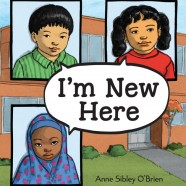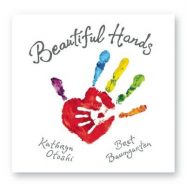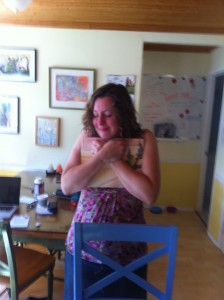How-To Poems and My Love of Hedgehogs
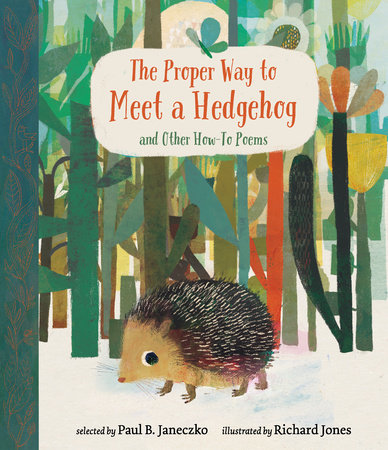
How-to poems are an easy introduction to poetry, to nonfiction, and to writing what you know. This book of poems selected by Paul B. Janeczko and illustrated by Richard Jones has such a wide range of topics that all your students will find at least one poem that they love. My favorites are “Toasting Marshmallows” by Marilyn Singer and “How to Scare Monsters” by Rebecca Kai Dotlich.
This book was given to me by fellow librarian Linda Pannuto because my storytimes always began and ended with Barb the Hedgehog. (She can curl up into a ball when she is shy.) And look at what Barb and I now have! Honey Hedgehog Cookies from Trader Joe’s AND a hedgehog purse! I’m all prickly with excitement!
Share “The Proper Way to Meet a Hedgehog and Other How-To Poems” and have students write an informational poem about what they know how to do. Share Honey Hedgehog Cookies while they write and get your own Folkmanis hedgehog puppet to share. Hands off the purse, though. That beauty is mine.
(Shout out to Lisa Wheeler and Janie Bynum for their book, “Porcupining: A Prickly Love Story” from which I stole Barb’s name. You two are sharp.)

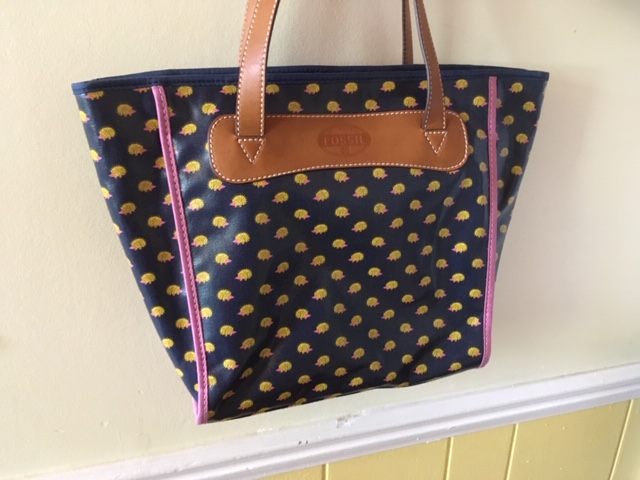
Start your new year off with compassion
This is a post I’ve shared before but I think it’s more important than ever to make your classroom a place of acceptance and compassion from day one.
It’s September, the start of a new school year. I have no apples for you teachers, but I do have the perfect back-to-school picture book to teach empathy and point of view: I’m New Here by Anne Sibley O’Brien.
Maria, Jin, and Fatimah are new to their schools and to the United States. Through their stories, we get a glimpse of what it’s like to hear a new language, to see a new alphabet, and to try to pick up a new set of classroom expectations. “Back home… I knew just what to do.” All of your students can relate to the unsettled feeling of a first day in a new classroom. With I’m New Here, you can expand upon that feeling to help your students empathize with people who are new to our country. I love that Anne Sibley O’Brien not only shows what it’s like to be an immigrant, but how we all learn from each other. On one page, O’Brien writes from Jin’s point of view, “I am learning from others. And they are learning from me.” Jin asks a little boy, “How to spell cloud?” The boy responds, “C-L-O-U-D.” Jin holds up a piece of paper with Korean characters on it. “This is cloud in Korean.” “Cool.”
Michelle A., a gifted kindergarten teacher of English as a Second Language students and a remarkable friend, told me about Step Inside thinking. After you’ve read through the book, ask your students to “step inside” a character and imagine that they are Maria, Jin, or Fatimah. Students can write and draw from the perspective of the character, describing what was a challenge and what helped. You can turn this book into a readers’ theater script for students to perform, or have students take on the roles in an impromptu performance as you reread the book. As a class, you can talk and write about what you all can do to help a new student feel welcome. Whether or not you gain a new student during the year, all of your students will gain a wider, more empathetic perspective from I’m New Here.
Read MoreCelebrate all the BEAUTIFUL HANDS!
 August is crazy-busy for teachers and parents of little learners, so grab this book for a quick-prep, interactive lesson: BEAUTIFUL HANDS by Kathryn Otoshi and Bret Baumgarten.
August is crazy-busy for teachers and parents of little learners, so grab this book for a quick-prep, interactive lesson: BEAUTIFUL HANDS by Kathryn Otoshi and Bret Baumgarten.
The book begins with a question, “What will your beautiful hands do today?” which leads to more questions with inspiration-sparking answers:
“Will they lift…/
spirits?/
Or stretch…/
imaginations?”
There are also invitations to participate (“What can you lift?” “What can you stretch?”) that will especially hook your movers and shakers.
All of the art is made of handprints, so after sharing the book, make handprint art! Paint, trace, color, cut, arrange into a mural that encourages us all to reach high. Write about what our hands can and will do, discuss how our hands are alike and still uniquely ours. Reread BEAUTIFUL HANDS and compare it to the book THE HANDIEST THINGS IN THE WORLD by Andrew Clements and Raquel Jaramillo. 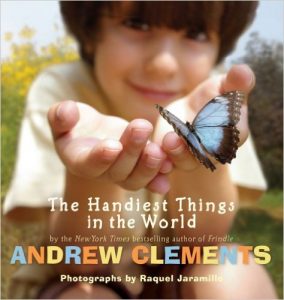
All who work with little ones deserve a big hand, so consider this post a “high five” from me to you as you start the school year!
Read MoreWHAT THE FUN?! in July and All Year ‘Round
Sing it with me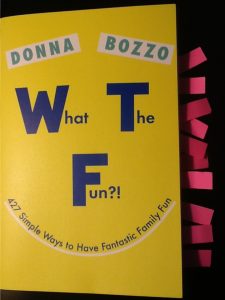 !
!
“What the world
Needs now
Is Fun!
WHAT THE FUN?!”
I picked something fun for July’s professional development book: WHAT THE FUN?! 427 Simple Ways to Have Fantastic Family Fun by Donna Bozzo. As you can see from my pink sticky tabs, I found lots of quick, easy, inexpensive ideas in WHAT THE FUN?! that work well in classrooms as well as at home, like:
- p. 35 “Comedy Club…Let the kids spend the day finding jokes and writing their own material.” Riddle and joke books can be less intimidating for some kids and make for meaningful reading and writing. Anthony, a wiggly first grader, found motivation for self-control when he knew that he could have time to shine as class clown at the end of the day. If everyone quickly got ready for home, the last few minutes before dismissal could be “open mic” time. I could remind Anthony when he got squirrelly during lessons to save it for when we could all enjoy it, a positive consequence instead of a negative one.
- p. 65 “Practice Speaking in a Kind Way and Teach Your Children to Do the Same:…say six nice things to six someones and make their day.” This can be a transition activity, a “brain break”, something to do while waiting in line, etc. Choose kids to compliment and to give compliments randomly (my students all had a class number so I’d just pull from a jar of numbered wooden sticks) or select someone and catch them being good. Some days it’s tough to remember to model kindness, so consider making this a daily or weekly routine.
- p. 149 “Groundhog Day Fun!” Donna Bozzo has
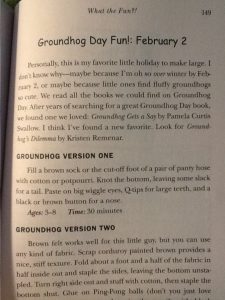 creative ways to share picture books with kids, and she came up with fantastic ideas to use with my book, GROUNDHOG’S DILEMMA! Donna, you made me swoon! I’m going to try both your suggestions for making a groundhog for retelling my story, and your cake with fun-sized candy bars decorated to look like groundhogs peeking up is yummy year ’round.
creative ways to share picture books with kids, and she came up with fantastic ideas to use with my book, GROUNDHOG’S DILEMMA! Donna, you made me swoon! I’m going to try both your suggestions for making a groundhog for retelling my story, and your cake with fun-sized candy bars decorated to look like groundhogs peeking up is yummy year ’round.
Here’s to us all having lots more fun! Thanks, Donna Bozzo!
Read MoreWhy I’ve Been Quiet for Six Months
MYSTERY OF LONG SILENCE EXPLAINED!
December, 2015:
My first two books, GROUNDHOG’S DILEMMA and
DRAW WITH A VENGEANCE (under the pen name, Helen Wrath), were published.
January, 2016:
I had a stroke.
I was in Boston at the American Library Association conference, attending for the first time not only as a librarian, but as a published author. I had a line at my booksigning event, dinner with a book promoter, brunch with my editor, coffee with an agent – and just before leaving for the airport, I lost all the peripheral vision on my right side. My husband called an ambulance and I spent four days at Tufts Medical Center recovering from an ischemic stroke.
I seemed to be slowly healing well, but in April I started having tremors and seizure-like episodes, up to eight a day. The four Michigan neurologists I saw were stumped.
Dr. Leung, the neurologist who treated me at Tufts, emailed to ask if he could interview me – he’s conducting research on young stroke survivors and I just barely still qualify as “young”! After the phone interview, this kind and generous doctor asked if I had any questions for him. I described the weird episodes, and he said, “If you’re ever in Boston, I’d be glad to see you as a patient.”
Off we drove to see Dr. Leung. Turns out I have epilepsy and most likely I’ve been having small seizures for years, maybe decades. (My friends used to tease me in high school about how I’d zone out. I was even diagnosed with a sleep disorder years ago because I’d have these odd, trancelike episodes that left me exhausted.) Having a stroke lowered my brain’s threshold for tolerating these electrical disturbances, hence the new tremors.
Now I’m on anti-seizure medication, and I’ve had only 3 small seizures in 15 days. If I hadn’t had the stroke while in Boston, I wouldn’t have seen Dr. Leung, and I might have gone on battling seizures without medication.
To make a long story longer, I am gratefully on the mend and will soon be bombarding your computer with more picture books that are just right for preschool – grade 3. Putting my entire life on pause while I healed made me realize how passionately I love what I do – writing and sharing great books for kids. Thanks for reading with me!
Read More
Groundhog’s Dilemma is here!
 It’s self-indulgent, but I can’t resist; my December pick is my new picture book that just hit the shelves, Groundhog’s Dilemma! It’s gorgeously illustrated by award-winning author/illustrator Matt Faulkner (with whom I’m about to celebrate five years of wedded bliss.)
It’s self-indulgent, but I can’t resist; my December pick is my new picture book that just hit the shelves, Groundhog’s Dilemma! It’s gorgeously illustrated by award-winning author/illustrator Matt Faulkner (with whom I’m about to celebrate five years of wedded bliss.)
Half of Groundhog’s friends want him to predict an early spring, and the other half want a longer winter. Groundhog wants to please everyone, so when February 2nd comes, Groundhog has a dilemma: to see or not to see his shadow?
Because the characters in this book have strong opinions and are trying to persuade our hero Groundhog (who is not immune to the lures of membership on a team or blueberry pie), use Groundhog’s Dilemma as a springboard for writing an opinion piece. I have a free, printable page on my website so students can write a persuasive letter to Groundhog (Core Writing Standard #1? Check!). Kids who send letters to Groundhog via my email or snail mail will receive responses!
Want more free? You’ll find printable puppets perfect for retelling the story, a comprehension chart, and fun facts on kristenremenar.com. I hope you enjoy it as much as these kiddos do!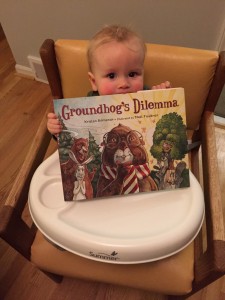
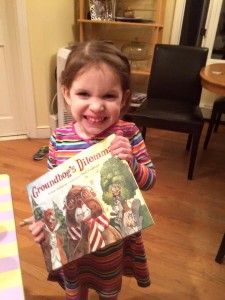
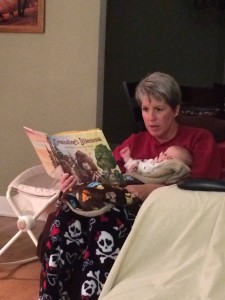
The Not Very Merry Pout-Pout Fish
 I’ve been hooked on Pout-Pout Fish since the beginning (fellow Michigander Debbie Diesen is a long-time friend), and the newest book, The Not Very Merry Pout-Pout Fish, is as wonderful as the original.
I’ve been hooked on Pout-Pout Fish since the beginning (fellow Michigander Debbie Diesen is a long-time friend), and the newest book, The Not Very Merry Pout-Pout Fish, is as wonderful as the original.
Mr. Fish feels caught up in the “tizzy-busy” rush of the holidays. (Dan Hanna does a brilliant job of tucking jokes in his illustrations of the packed store shelves!) The repetition of these lines not only supports our early readers, it completely captures the overwhelmed feeling many of us get :
“For a gift should be big,
And a gift should be bright,
And a gift should be perfect –
Guaranteed to bring delight.
And a gift should have meaning,
Plus a big of bling-zing,
So I’ll shop till I drop
For each just-right thing!”
When Mr. Fish has shopped until he’s plopped and still worries that his friends will be disappointed, the lovely Miss Shimmer reminds him that “the best gifts of all come straight from the heart.” Together they make wonderful gifts and, most importantly, enjoy their time with their fishy friends.
Let’s scale back this season. Share The Not Very Merry Pout-Pout Fish with your kiddos, and talk about what you can make and do instead of buy. Consider replacing physical gifts with shared activities. I know some grown-ups who’d prefer the gift of a Readers’ Theater performance of this story to receiving another bag of potpourri. I wish you all oceans of joy and contentment this year!




